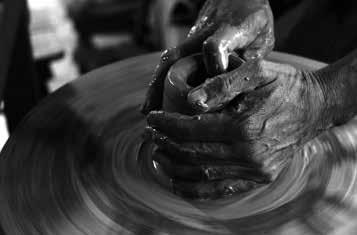
3 minute read
Ceramic Art
DESIGN — Ceramic Art: The new zen
Why did the «New York Times» write that it is the «new yoga»?
Advertisement
You will have seen it on Instagram or a friend will have told you: Ceramic art is gaining ground as a hobby. Not only because it resembles meditation and gives space to our creativity, but also it restores our relationship with touch, soil and fire, away from screens.
When you put your hands to clay, the natural inclination to form, shape, and ultimately create something from the fine-grained soil is inescapable. Ceramics are perhaps the most ubiquitous of all art forms to have emerged from human history. The art of ceramics has endured for eons, with a rich legacy of thousands of years of creation and know-how, passed down from generation to generation.
Ceramics (derived from «Keramos», Greek for «potter’s clay») is one of the most ancient industries going back thousands of years. Even though there is a long history of ceramic art in almost all developed cultures, it particularly thrived during Greek antiquity in an inspired verve of shapes, colors, and figures. In fact, many art critics consider Greek pottery to represent the zenith of ceramic art; but despite the aesthetic achievements of many outstanding Greek ceramicists, the plastic art of pottery in Classical Antiquity was never as widely respected as fine art. With its inception lost in the prehistoric times, it thrived during the Greek antiquity in an inspired verve of shapes, colours, figures. Storage-jars, amphoras, kraters, jugs, and lekythoi reflect the everyday habits and the traditions of the society that produced them and they give evidence about that society, as pottery accounts for the most numerous objects of the same category found in any archaeological excavation.
In the modern era, new morphologic and technical features have been added to making ceramics. Earthenware

The relationship between hands and clay is the basis of the ceramic art form. Ceramics—in the form of bricks, tiles, vessels, and sculptures—have endured for millennia, and the medium continues to be explored today.

jars have helped storing the harvest, while pitchers and flasks have contained liquids, and cooking-pots and dishes have been used as tableware. The forms have been rather simple, but the decorative touch– an exclusive task of the craftsmen’ wives- has sealed the crafted items with grace and sensitivity. Ornamental patterns such as stripes, coils, lines, flowers, leaves, fish, birds, and ship lift the humble clay up on a level of sheer folk art.
The more recent days of glory of the Greek ceramic art have been spent in the mainland (Macedonia, Peloponnese, Thrace, Attica) and on several islands (Thasos, Lesvos, Samos, Crete, Skyros, Aegina, Rhodes, Sifnos). The age-old tradition and the inherited knowledge have never ceased to drive the hands, the imagination and the artistry of the clay modellers.

In recent years, there has been an explosion of interest in ceramics - whether it is Brad Pitt practicing with his friend Leonardo DiCaprio in the studio of the former, or just for all of us who have found a new means of expression. Today, pottery workshops are springing up in the neighborhoods of Athens, while art spaces dedicated to the promotion of ceramics are also opening. Why? Because ceramics is a healing art. The soul heals. The mind calms down during these 3-4 hours that a lesson can last. It offers great satisfaction to make something of your own, with your own hands, it has magical aspects.
151










